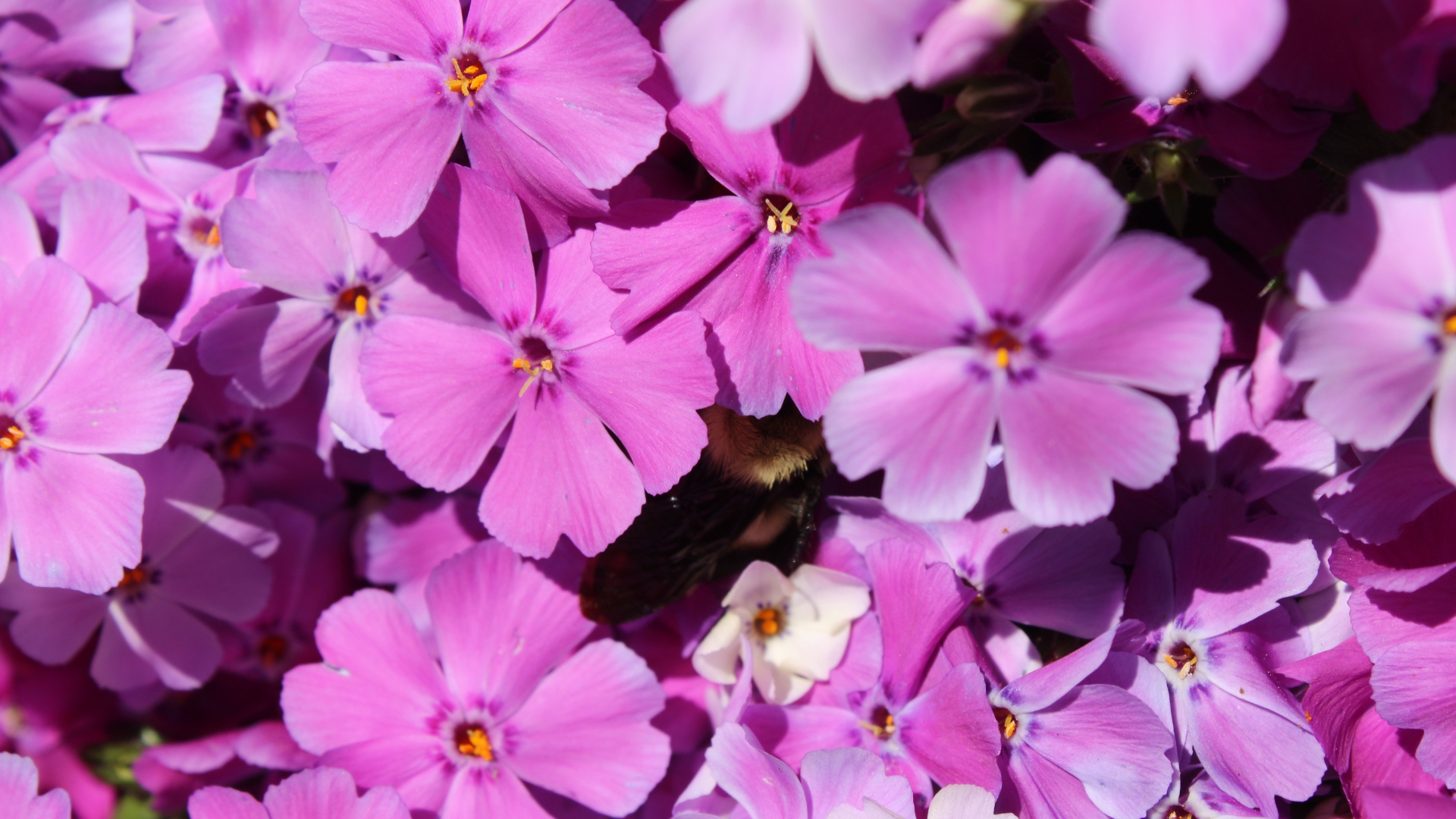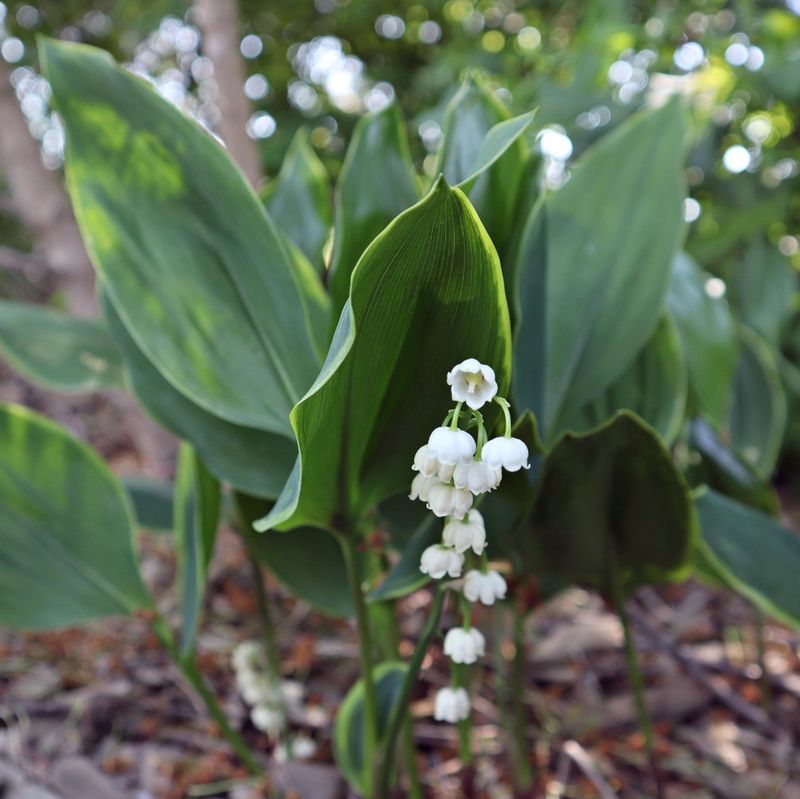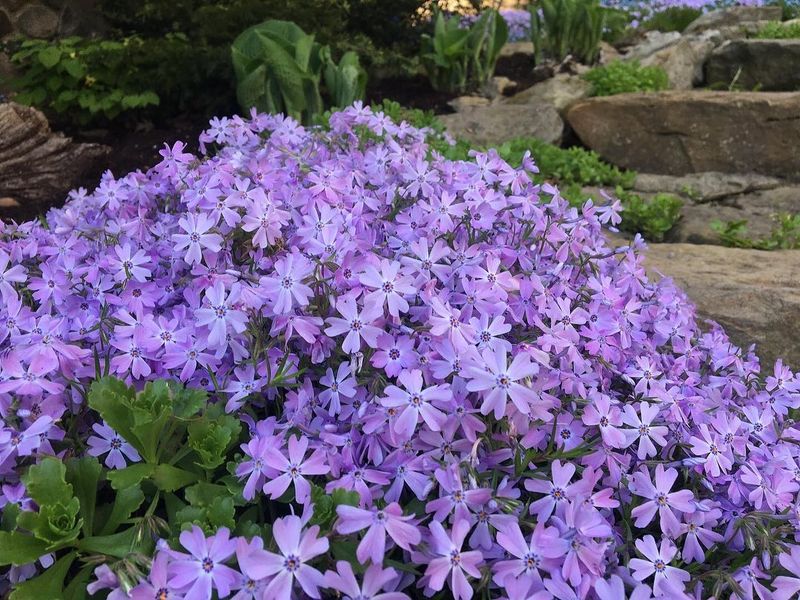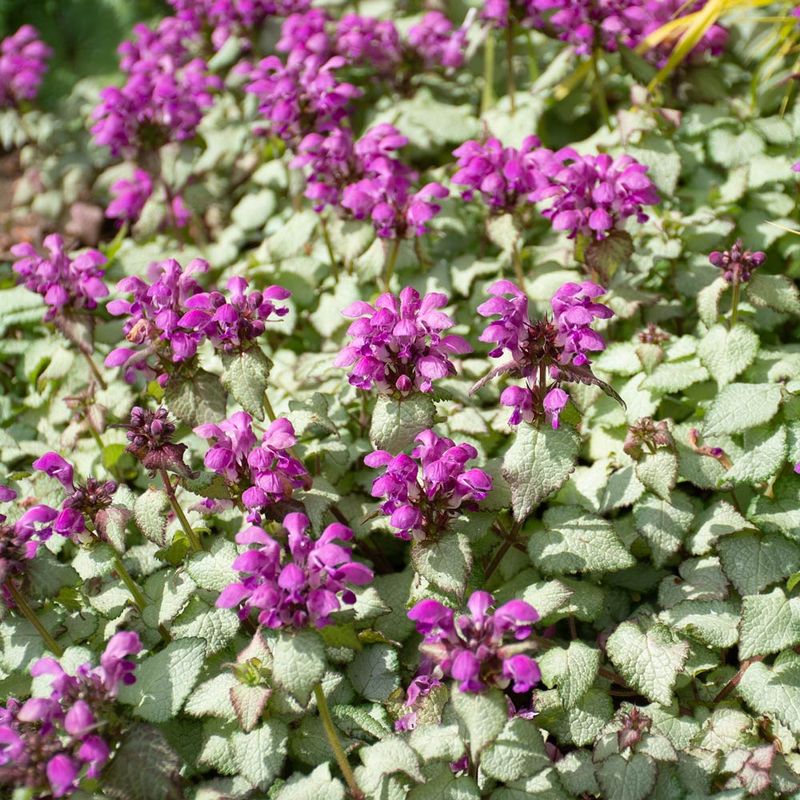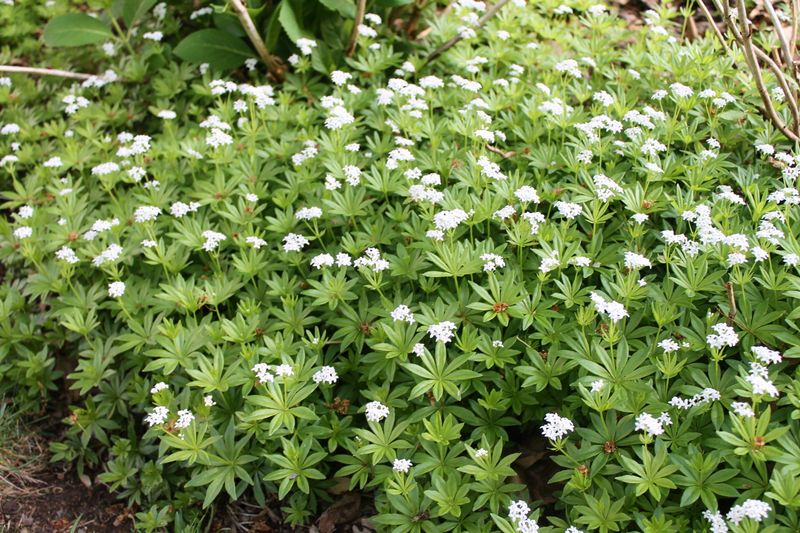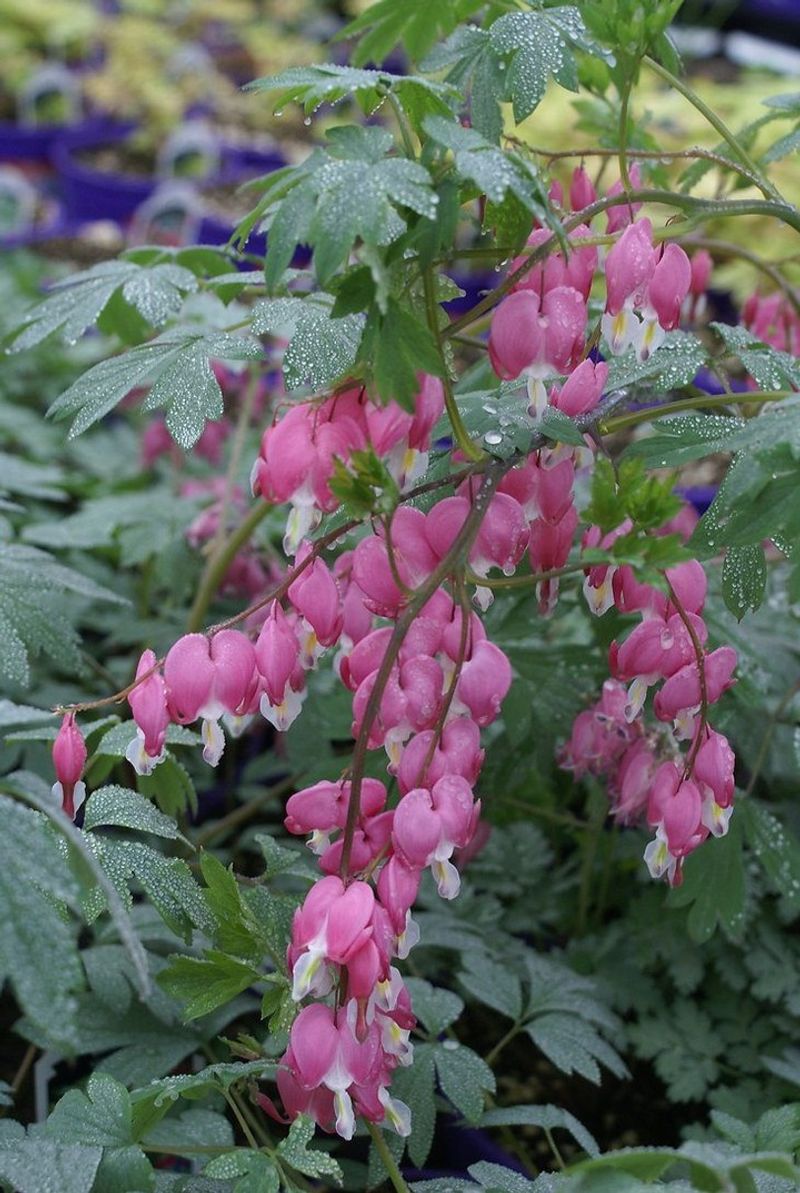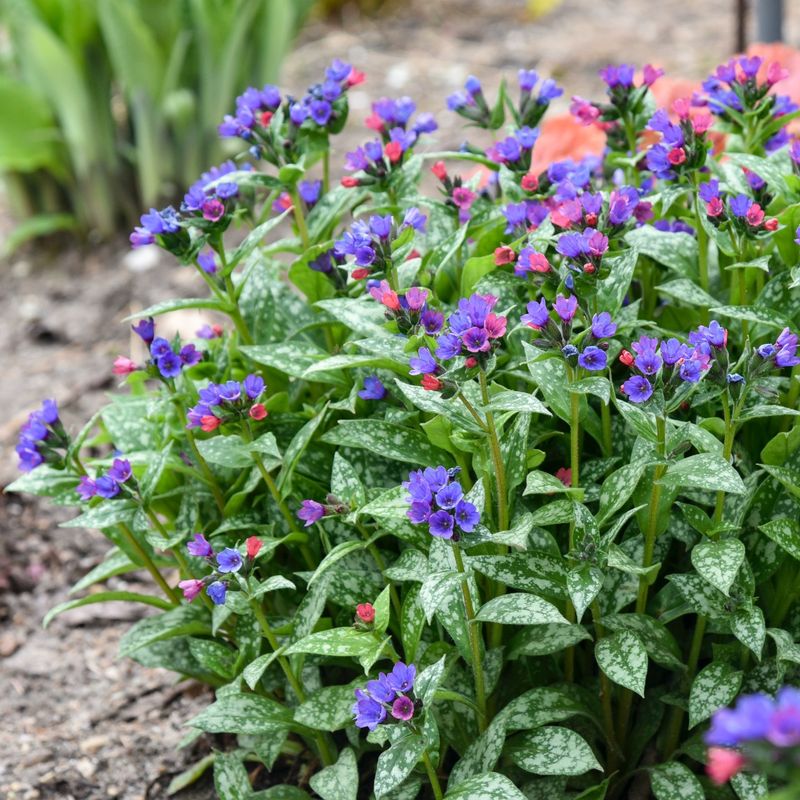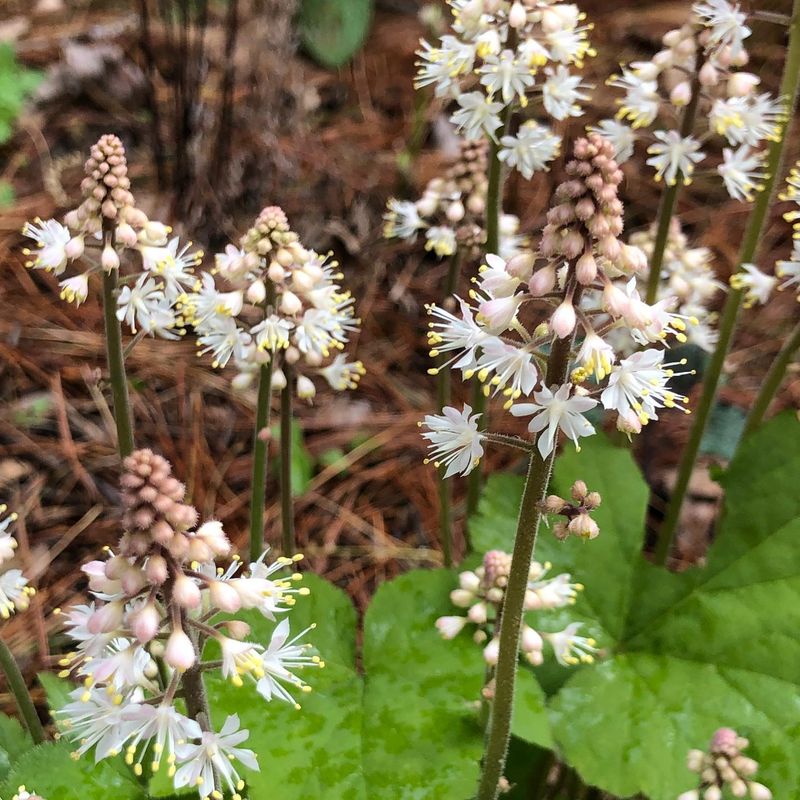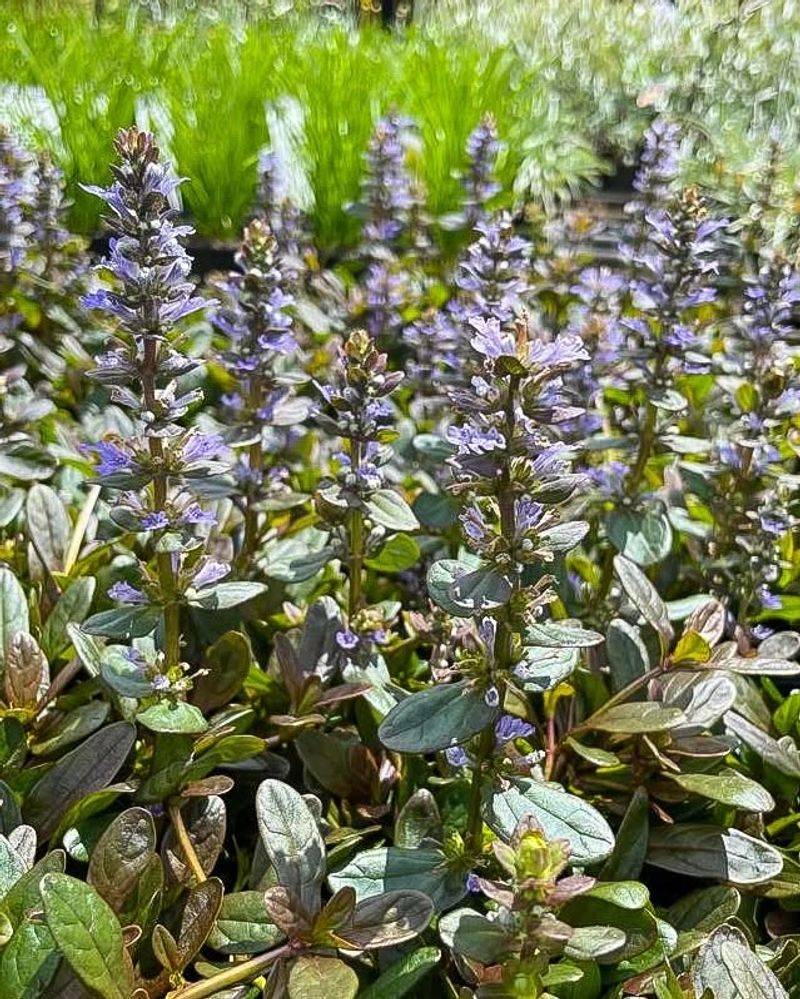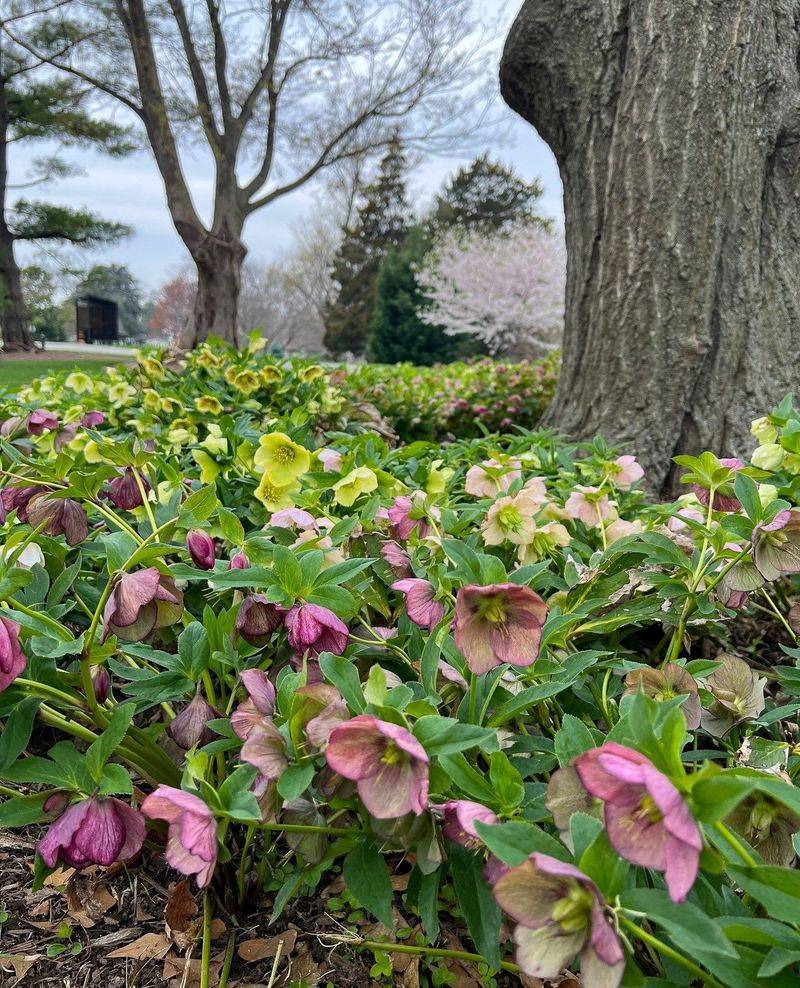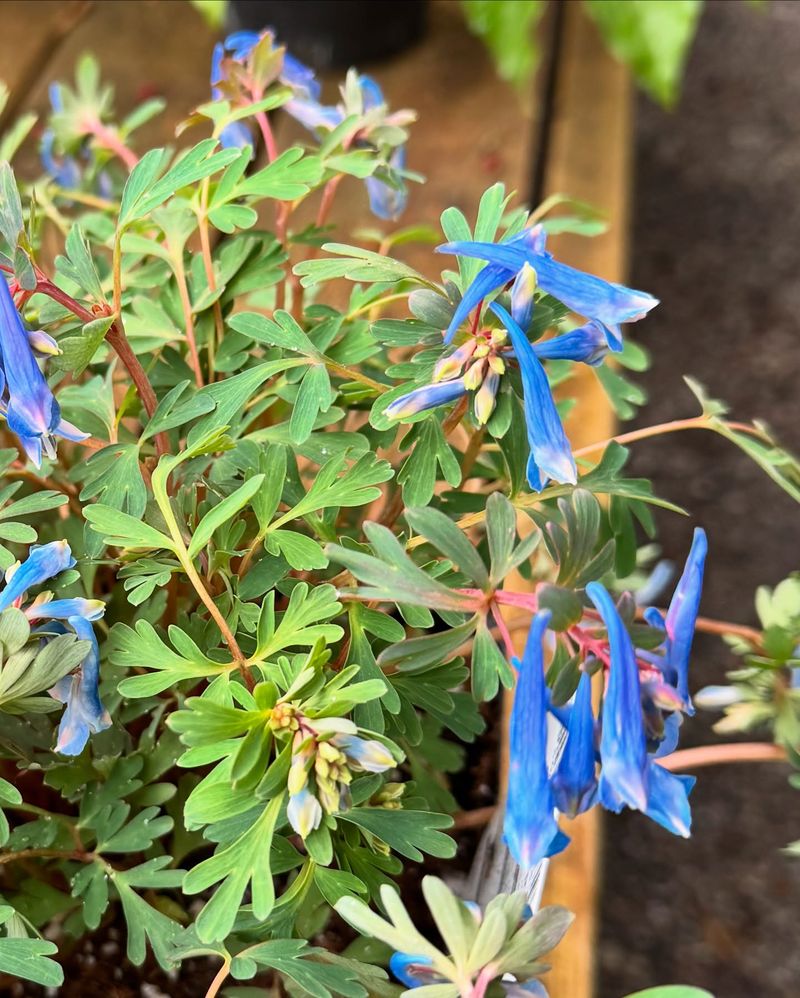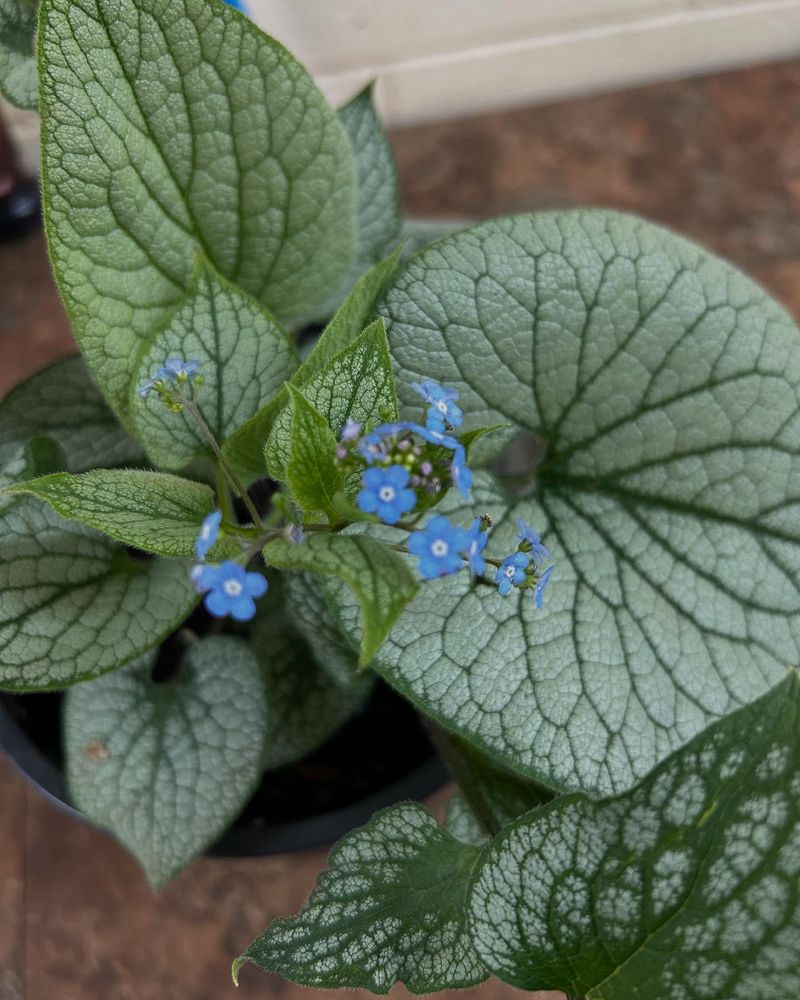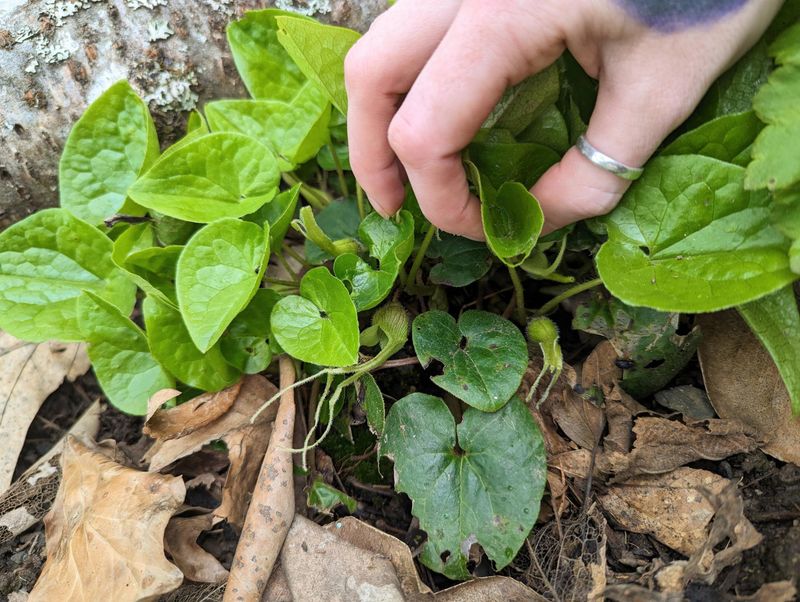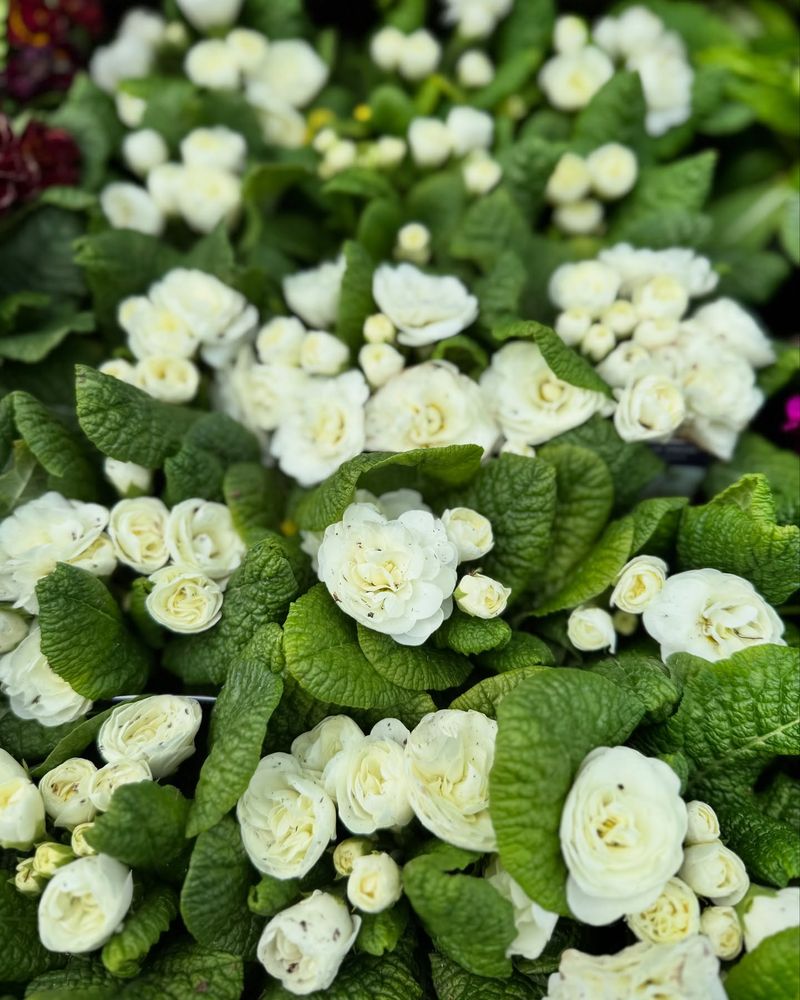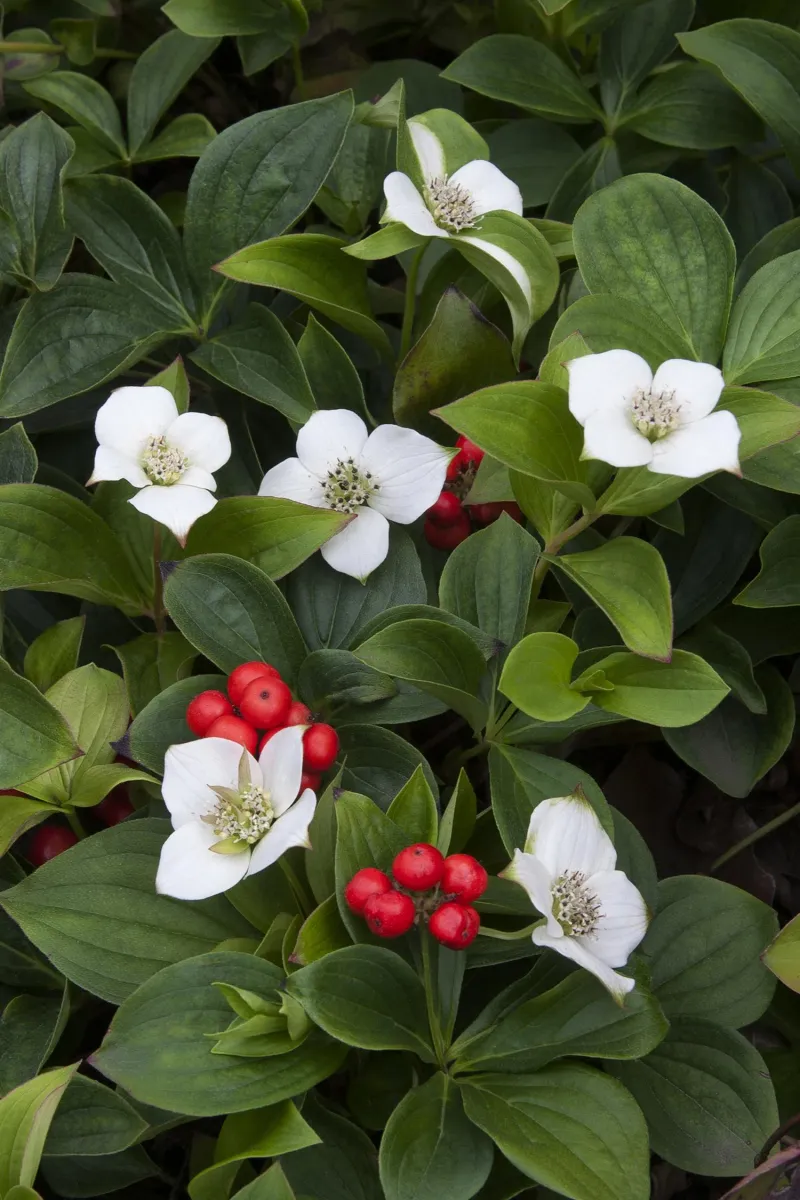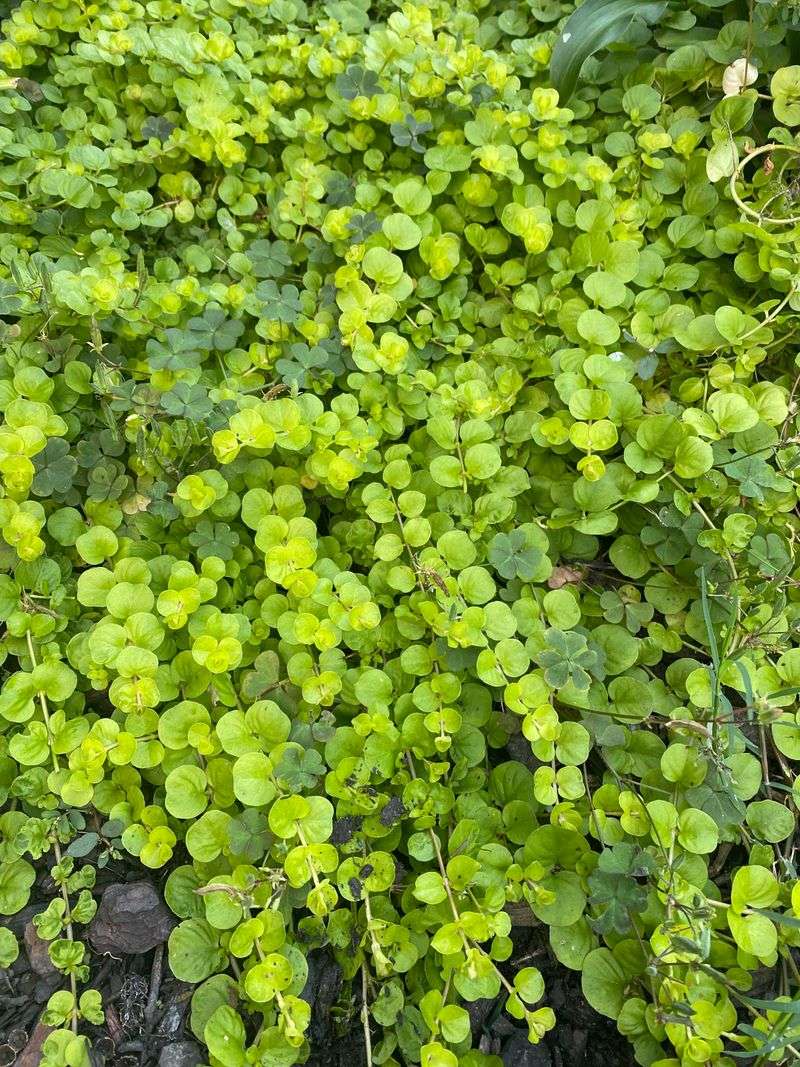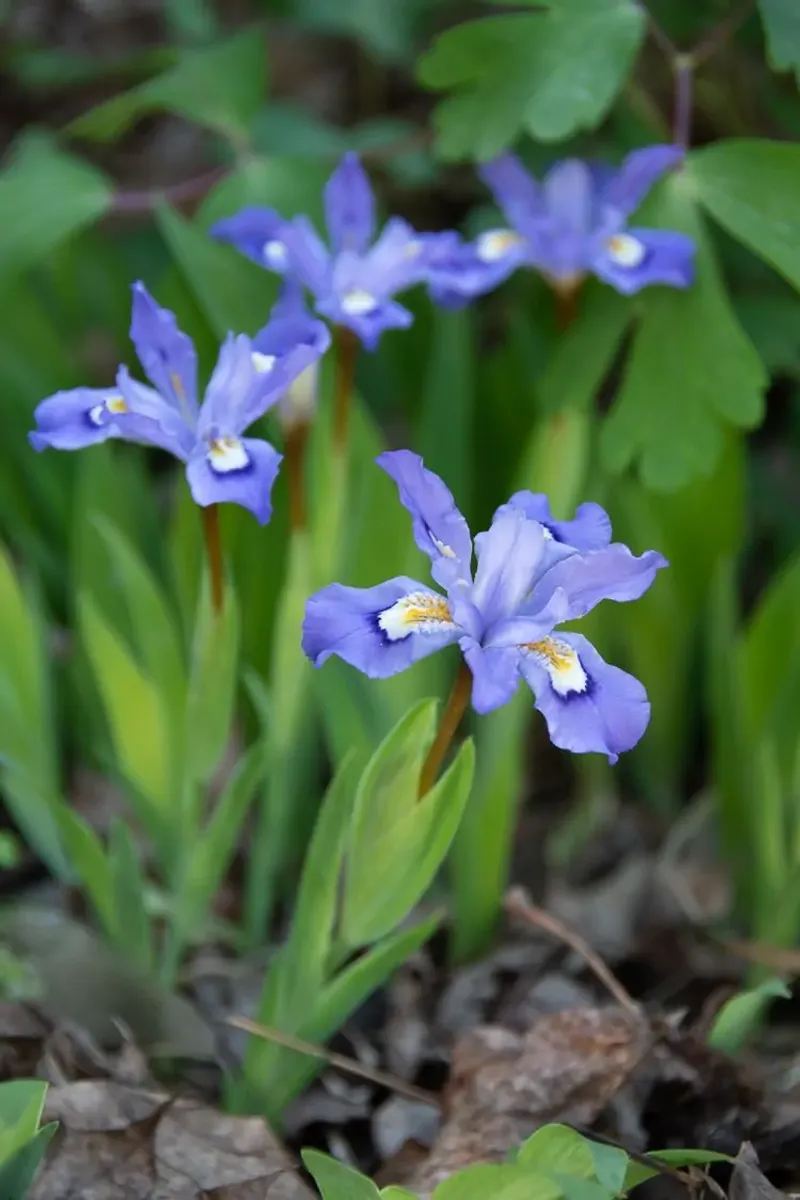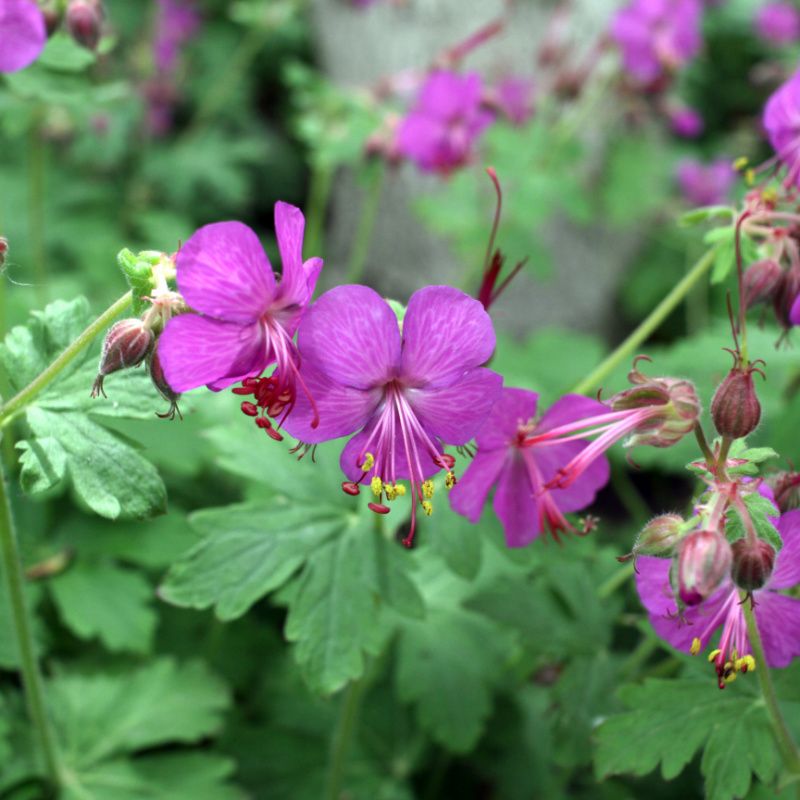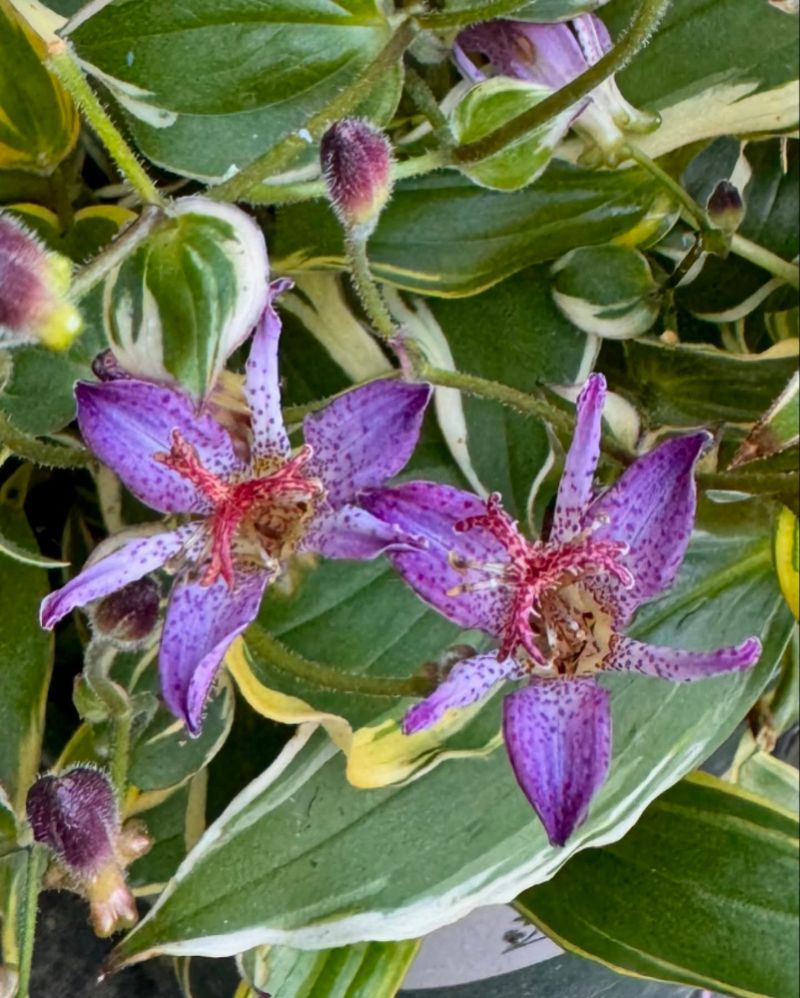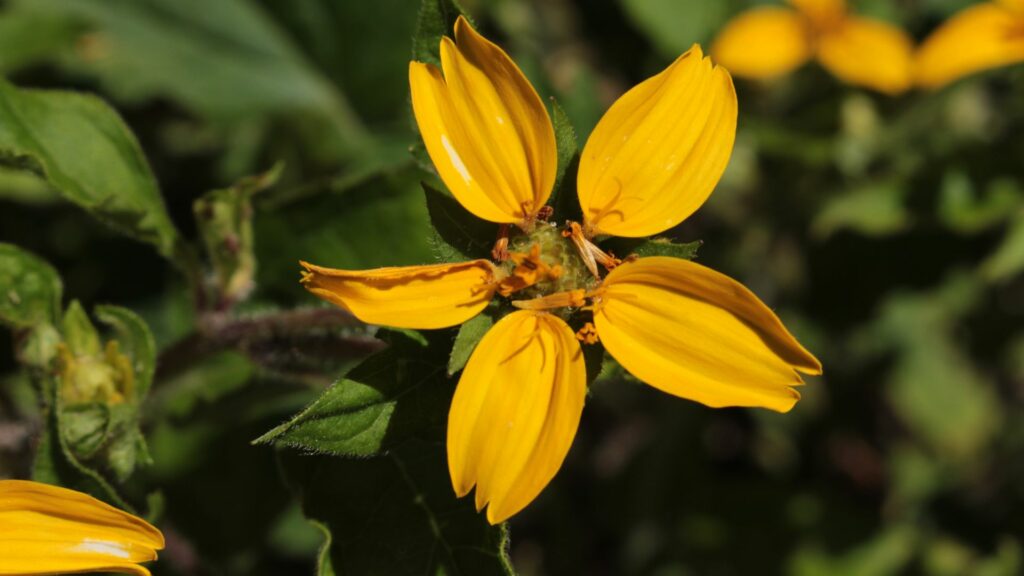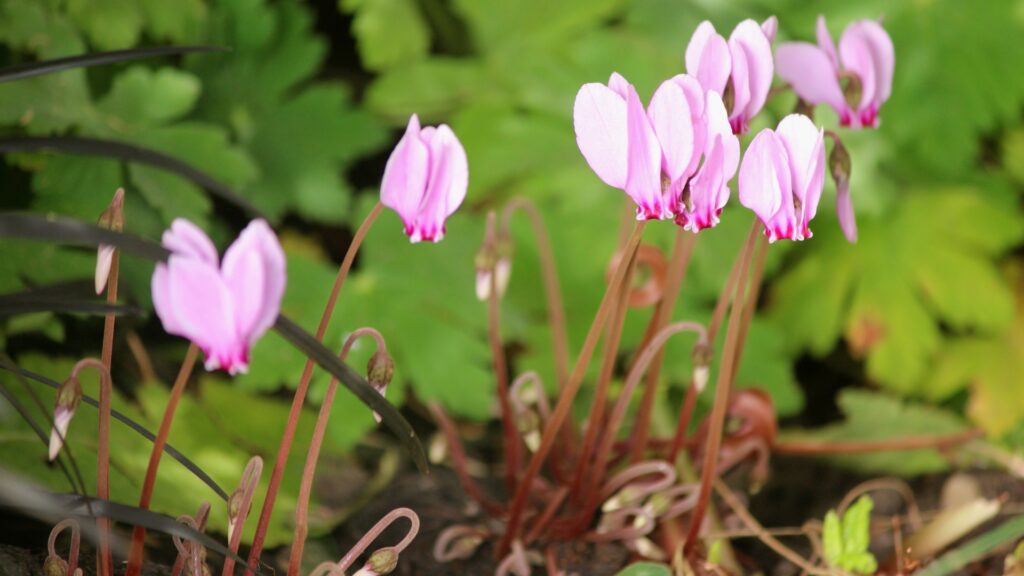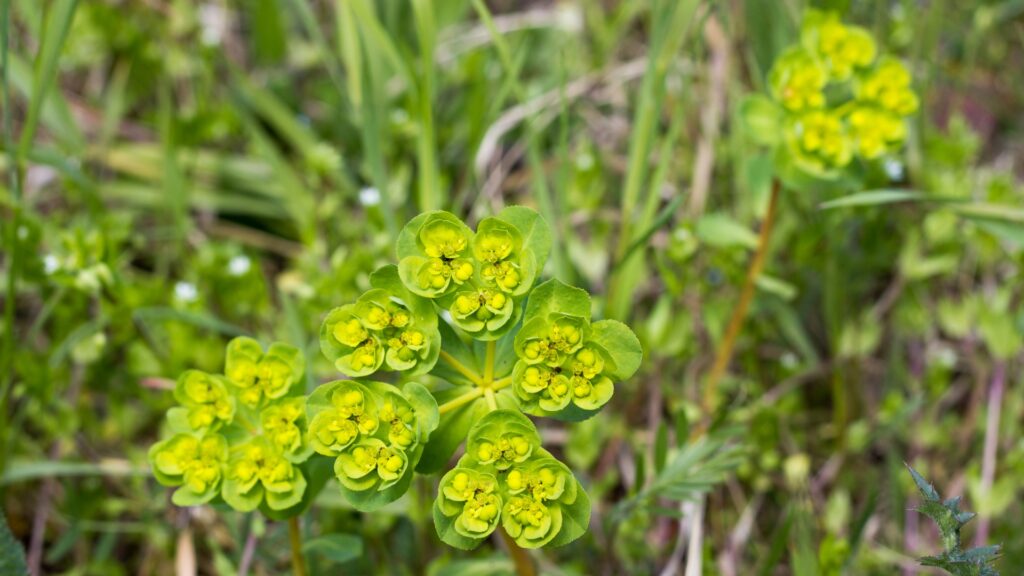Shady spots under trees can feel like a gardener’s dead end—where grass quits and nothing sticks. But don’t throw in the trowel!
With the right ground covers, those gloomy patches can become the most charming corners of your yard.
1. Lily Of The Valley
Those fragrant white bell-shaped blooms have been stealing hearts for generations. I planted a small patch three years ago, and now it’s formed a delightful carpet under my old oak tree.
Lily of the Valley prefers partial to full shade and thrives in rich, moist soil. Once established, it spreads steadily through underground rhizomes, creating a dense mat of glossy green foliage that chokes out weeds effectively.
The sweet perfume these tiny flowers release in spring makes them worth every inch of space they claim. Just remember they’re poisonous if ingested – something to consider if you have curious pets or small children around.
2. Creeping Phlox
Morning walks through my garden changed when I added creeping phlox beneath my maple trees. The carpet of purple, pink, or white flowers in spring never fails to lift my spirits, even on the gloomiest days.
Unlike many shade-lovers, creeping phlox enjoys slightly acidic soil, making it perfect for planting near pine trees. Its needle-like evergreen foliage forms a tight mat year-round, preventing soil erosion on gentle slopes while looking attractive even when not in bloom.
Give it some breathing room when planting – about 12-18 inches between plants. Though it prefers dappled shade, too much darkness can reduce flowering, so aim for spots that get morning sun if possible.
3. Lamium (Dead Nettle)
Silver-streaked foliage that brightens dark corners made me fall in love with Lamium instantly. After struggling with a barren patch under my crabapple tree for years, this plant transformed the area in just one season.
The pink, purple, or white flowers appear in spring and often continue sporadically through summer. What makes Lamium truly special is its drought tolerance once established – I barely watered mine last summer, yet it remained lush while other plants wilted.
Varieties like ‘Purple Dragon’ and ‘White Nancy’ have particularly showy blooms. Deer and rabbits typically avoid it, adding to its carefree nature in woodland gardens where critters often feast on tender plants.
4. Sweet Woodruff
The sweet, hay-like fragrance of dried Sweet Woodruff takes me back to my grandmother’s garden. This delicate-looking plant with whorled leaves and tiny star-shaped white flowers creates a fairy-tale setting under deciduous trees.
Sweet Woodruff spreads steadily but isn’t aggressive in most gardens. Its bright green foliage emerges early in spring and forms a tidy mat 8-12 inches tall. The flowers appear in May, creating a frothy white display that complements spring bulbs beautifully.
My favorite feature is how it thrives in dry shade – those problematic spots where tree roots compete for every drop of moisture. Once established, it requires almost no maintenance beyond occasional thinning if it spreads too enthusiastically.
5. Bleeding Heart
Heart-shaped pink or white flowers dangling from arching stems create a romantic vignette in shady corners. My neighbor laughed when I planted these delicate-looking perennials under my massive maple, betting they wouldn’t survive.
Three years later, those same bleeding hearts have formed substantial clumps that burst into bloom each spring. The ferny foliage provides textural interest even after the flowers fade. In hotter climates, they may go dormant in summer – a perfect opportunity to plant late-emerging companions nearby.
Fringed bleeding heart (Dicentra eximia) offers a longer bloom season than the classic type (Dicentra spectabilis) and stays more compact, making it especially suitable as a flowering ground cover for smaller spaces.
6. Lungwort (Pulmonaria)
The spotted foliage alone would earn Lungwort a place in my shade garden, but the color-changing flowers make it truly special. Watching the blossoms shift from pink to blue as they mature reminds me why I became a gardener – to witness these small, daily miracles.
Pulmonaria thrives in the challenging environment created by shallow tree roots. Its fuzzy leaves resist deer browsing and retain moisture, helping the plant survive dry spells. Unlike many shade plants that bloom only briefly, newer varieties like ‘Raspberry Splash’ flower for weeks.
Plant it where you’ll regularly pass by in early spring to enjoy the unique blooms. Their low-growing habit makes them perfect for edging woodland paths or creating colorful drifts beneath deciduous trees.
7. Foam Flower (Tiarella)
Foamy spires of tiny star-shaped blooms hover above maple-like foliage in spring, creating an ethereal effect in woodland gardens. I discovered foam flowers by accident at a plant sale five years ago and now can’t imagine my garden without them.
Native to North American forests, Tiarella feels right at home beneath trees. The lobed leaves often feature dramatic dark veining or purple blotches that provide visual interest long after the flowers fade. Some varieties even turn bronze or burgundy in fall.
Foam flowers pair beautifully with ferns and hostas, creating woodland vignettes that evoke natural forest floors. For maximum impact, plant them in drifts of 5-7 plants – they’ll gradually spread to form a cohesive carpet.
8. Ajuga (Bugleweed)
Glossy, often purple-tinged foliage caught my eye first, but the electric blue flower spikes that emerge in spring sealed the deal. Ajuga transformed a bare patch under my pines where nothing else would grow.
This tough-as-nails ground cover forms a dense mat that effectively suppresses weeds. Varieties like ‘Black Scallop’ and ‘Chocolate Chip’ offer dramatic leaf colors that brighten shady areas even when not in bloom. The plants spread by runners, quickly filling gaps between stepping stones or around tree trunks.
Bees absolutely adore the flowers, making Ajuga an excellent choice for gardeners looking to support pollinators. Just keep it away from lawn areas – its vigorous spreading habit can make it difficult to contain once established.
9. Hellebores (Lenten Rose)
February in my garden used to be bleak until I discovered hellebores. Now, these elegant nodding flowers bring color to the darkest days of late winter, sometimes pushing through snow to bloom.
Unlike many ground covers that spread aggressively, hellebores form well-behaved clumps that gradually increase in size. Their leathery, evergreen foliage remains attractive year-round, providing structure even when other perennials disappear.
Plant them where you can easily view the downward-facing blooms – perhaps along a raised bed or hillside. Their deer-resistant nature makes them invaluable in woodland settings where four-legged visitors often browse.
10. Epimedium (Barrenwort)
Discovering Epimedium was like finding a secret gardening cheat code. These tough-as-nails perennials thrive in the most challenging conditions – dry shade, tree root competition, even clay soil – while looking delicate and refined.
The heart-shaped leaves emerge with bronze or red tints in spring, accompanied by dainty flowers that resemble tiny fairy lanterns dancing above the foliage. By summer, the leaves form a solid weed-suppressing mat that stays attractive until frost.
My favorite variety is ‘Frohnleiten’ with its bright yellow flowers, but there are dozens to choose from with blooms in white, pink, purple, and orange. Give them a light trim in late winter to showcase the fresh spring growth and flowers.
11. Corydalis
The electric blue flowers of Corydalis flexuosa stopped me in my tracks at a botanical garden years ago. I’d never seen such an intense blue in a shade plant, and I immediately sought it out for my own garden.
Ferny foliage creates a delicate texture that contrasts beautifully with broader-leaved shade plants like hostas. While some species go dormant in summer heat, others like C. lutea bloom from spring through frost. Most prefer moist but well-drained soil rich in organic matter.
Yellow corydalis self-sows gently, creating naturalized drifts over time without becoming invasive. The blue-flowered types tend to be shorter-lived but are so spectacular that they’re worth replanting every few years when they decline.
12. Brunnera (Siberian Bugloss)
Silver-splashed heart-shaped leaves create a luminous effect in dark corners, almost like moonlight captured in plant form. After seeing ‘Jack Frost’ Brunnera in a garden center display, I cleared space under my river birch the very same day.
Clusters of tiny blue flowers that resemble forget-me-nots appear in spring, hovering above the striking foliage. While the flowers are charming, it’s the leaves that make Brunnera a standout performer in shade gardens. They brighten dark spots and create striking combinations with ferns and hostas.
Unlike many variegated plants that can revert or scorch, Brunnera maintains its beautiful patterning reliably year after year. Just provide consistent moisture and watch for slugs, which sometimes find the leaves as appealing as we do.
13. Wild Ginger (Asarum)
Hidden beneath the glossy, heart-shaped leaves are some of the most unusual flowers in the plant kingdom – small, brownish-purple blooms that rest on the ground, often beneath the foliage. I’ve watched ants carrying their seeds, helping wild ginger spread slowly through my woodland garden.
European ginger (Asarum europaeum) forms an elegant evergreen carpet with glossy leaves, while our native Canadian wild ginger (Asarum canadense) dies back in winter but grows more quickly. Both thrive in the difficult conditions found under mature trees.
The slow-spreading nature of wild ginger makes it perfect for edging woodland paths or surrounding specimen plants. Its natural appearance suits native plant gardens and creates authentic-looking woodland scenes when paired with ferns and spring ephemerals.
14. Primrose (Primula)
Jewel-toned blooms in yellow, pink, purple, and blue bring the cheerfulness of cottage gardens to shaded spots. My grandmother always had primroses under her apple trees, and planting them in my own garden connects me to those childhood memories.
Different species offer varied looks, from the clustered flowers of polyanthus types to the tiered whorls of candelabra primroses. Many bloom in early spring alongside bulbs, while others flower in late spring or early summer. Most prefer consistently moist soil rich in organic matter.
For especially challenging dry shade, try Primula vulgaris, the common primrose. It’s tougher than it looks and will self-sow gently once established, creating natural-looking drifts that appear as if they’ve grown there forever.
15. Bunchberry (Cornus canadensis)
Native plant enthusiasts treasure this diminutive member of the dogwood family for its four-season interest. The plant appears to have white flowers, but what looks like petals are actually modified leaves surrounding the true tiny flowers in the center.
Bright red berries follow the spring blooms, creating striking contrast against the whorled green leaves. Fall brings burgundy foliage that extends the show before winter dormancy. At just 6 inches tall, bunchberry forms a tidy groundcover that spreads slowly through underground stems.
Growing bunchberry successfully requires acidic, humus-rich soil similar to what you’d provide for blueberries. It pairs beautifully with other woodland natives like ferns, trilliums, and foamflower to create authentic forest floor plantings.
16. Creeping Jenny (Lysimachia nummularia)
Golden coins of foliage tumbling over rocks and logs brightened my shaded streambed garden beyond my expectations. The ‘Aurea’ variety glows like sunshine even in the darkest corners, creating ribbons of light between larger shade plants.
Yellow cup-shaped flowers appear in summer, adding yet another layer of golden color. While creeping Jenny can spread enthusiastically in ideal conditions, shade and competition from tree roots keep it more contained. The stems root as they creep along the ground, helping prevent erosion on slopes.
I’ve found it particularly useful for softening the edges of water features in shade and filling gaps between stepping stones. Just be cautious about planting the green form near natural areas, as it can be invasive in some regions.
17. Fringed Bleeding Heart (Dicentra eximia)
Unlike its larger cousin with the arching stems, fringed bleeding heart forms tidy mounds that bloom from spring until frost. The staying power of this native perennial amazed me – while other plants faded in summer’s heat, it kept producing delicate pink hearts above ferny blue-green foliage.
Hummingbirds frequently visit the dangling flowers, adding movement and life to shady corners. The finely-cut foliage creates a soft, airy texture that complements broader-leaved shade plants like hostas and heucheras.
Fringed bleeding heart self-sows modestly, creating naturalistic drifts over time without becoming a nuisance. Its compact size (about 12-18 inches tall and wide) makes it perfect for edging woodland paths or filling the middle ground between taller shrubs and shorter ground covers.
18. Dwarf Crested Iris (Iris cristata)
Miniature iris blooms in spring never fail to delight visitors to my woodland garden. Standing just 6 inches tall, these native charmers produce lavender-blue flowers with distinctive gold crests that seem to glow in dappled shade.
The spreading rhizomes form a dense mat of strappy foliage that effectively suppresses weeds while creating an attractive ground cover year-round. Unlike bearded iris that need full sun, dwarf crested iris thrives in the filtered light beneath deciduous trees.
Combining them with early spring bulbs extends the season of interest – try interplanting with snowdrops or species tulips that will bloom before the iris foliage fully develops. For maximum impact, plant in drifts of at least a dozen rhizomes spaced about 8 inches apart.
19. Bigroot Geranium (Geranium macrorrhizum)
Aromatic foliage that smells like pine when brushed against makes bigroot geranium a sensory treat in the garden. I planted a few small divisions along my shaded walkway years ago, and they’ve formed a beautiful weed-suppressing carpet that blooms reliably each spring.
The magenta, pink, or white flowers hover above the scalloped leaves for several weeks, followed by attractive reddish seed pods. Autumn brings brilliant red and orange foliage that persists well into winter in mild climates. Even in deep shade, this tough plant blooms abundantly.
Drought tolerance once established makes bigroot geranium perfect for those difficult dry shade spots under mature trees. Its thick rhizomes store water and nutrients, helping it survive challenging conditions that would kill less adapted plants.
20. Toad Lily (Tricyrtis)
Orchid-like spotted flowers in late summer and fall appear just when the shade garden needs a boost. The first time I saw toad lilies blooming, I couldn’t believe such exotic-looking flowers could grow in my cold-winter climate.
Arching stems carry the unique blossoms, which are typically white or pale purple with dark purple spots. Some varieties also feature variegated foliage that brightens shady areas even before the plants bloom. They prefer consistent moisture but will tolerate short dry spells once established.
Plant toad lilies where you can appreciate their intricate flowers up close – perhaps along a woodland path or near a seating area. Their late bloom time pairs beautifully with autumn ferns and the seedheads of earlier-flowering shade plants.
21. Golden Star
This cheery native ground cover surprised me with its resilience. I planted it under a young redbud tree, and within a season, its bright yellow, daisy-like flowers were lighting up the area like little sunbursts on the forest floor.
Golden star blooms from spring into summer and sometimes beyond, especially with a little deadheading. The fuzzy green foliage forms a low, spreading mat about 4–6 inches tall, making it ideal for the front of shady beds or as a living mulch around shrubs.
It handles partial to full shade well and tolerates a range of soil types, as long as they’re not bone-dry. Plus, pollinators adore the flowers, adding even more life to those shady corners.
22. Canadian Anemone
White, buttercup-like blooms float above lush green leaves in late spring, bringing a soft, woodland charm to shady corners. I added Canadian anemone beneath a stand of black walnuts—an area where nothing else would grow—and was stunned by its resilience.
This native ground cover spreads vigorously through underground rhizomes, so it’s best suited for areas where you want fast, natural coverage. Despite its aggressive growth, it’s not hard to control with seasonal thinning, and the flowers more than make up for its enthusiasm.
Pollinators appreciate the blooms, and the foliage stays full through summer. It’s especially useful for quickly covering problem spots under mature trees or along woodland edges where erosion is an issue.
23. Hardy Cyclamen (Cyclamen hederifolium)
Each autumn, when most flowers are fading, hardy cyclamen sends up its dainty, swept-back blooms in shades of pink, white, or lavender—like little butterflies dancing above the forest floor. I first spotted this plant beneath an old beech tree in a public garden and immediately hunted it down for my own shady border.
The marbled, heart-shaped leaves follow the blooms and persist through winter before going dormant in summer. This unique growth cycle makes it a perfect companion to spring ephemerals or hostas, filling in the seasonal gaps.
Cyclamen thrives in dry shade and tolerates root competition well. Once established, it naturalizes gently by seed, creating magical drifts over time. It’s especially striking when planted in groups among moss, rocks, or at the base of deciduous trees where it can truly shine.
24. Japanese Spurge (Pachysandra terminalis)
This classic evergreen ground cover may not be flashy, but its reliability in deep shade makes it an indispensable part of many woodland gardens. I used it to unify a tricky spot under a mature spruce where few other plants would grow, and it’s been thriving ever since.
Small, white flower spikes appear in early spring, but the real appeal lies in the dense mat of glossy green leaves that hold their color year-round. It creates a clean, tailored look beneath trees, around foundations, or along shaded pathways.
Japanese spurge spreads slowly by underground stems and is low enough (around 6–10 inches) to pair beautifully with taller perennials or spring bulbs. While not ideal for hot, dry climates, it excels in cool, moist, shaded sites where other ground covers falter.

